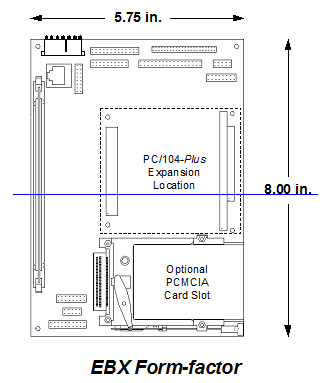See all EBX Products
Until now, embedded system designers had to choose among off-the-shelf backplane solutions, desktop motherboards, and proprietary designs. Size and power consumption constraints hampered finding the right solutions for embedded deployment. Consequently, OEMs wanting to purchase off-the-shelf equipment to shorten time-to-market were often forced to develop proprietary solutions.
Standards are important to the embedded systems market. Popular backplane form-factors — including VME, CompactPCI™, Multibus™, STD32®, and passive backplane ISA — are well documented mechanical and electrical standards. Desktop motherboards, which fit certain high-end embedded applications, also follow standards such as Baby AT, LPX, ATX, and the NLX standard. All these standards allow vendors and OEMs to create products that are easily packaged in enclosures and readily expanded via open interfaces. However, none of these backplane-based standards satisfy the unique space, power, and reliability constraints of small embedded systems.
The availability of an embedded single-board computer (SBC) standard will ensure that embedded computing solutions can be designed into space constrained environments with off-the-shelf components. The embedded market constantly demands improvements in functionality and performance, while at the same time seeking size and cost reduction. The “Embedded Board, eXpandable” (EBX) standard creates the opportunity for solutions which fit the requirements of embedded system OEMs; takes advantage of trends in the embedded computing market; and offers the convenience, flexibility, risk reduction, and scalability of multi-sourced off-the-shelf products.
 The “Embedded Board, eXpandable” (EBX) standard is the result of a collaboration between industry leaders to unify the embedded computing industry on a small footprint embedded single-board computer standard. The EBX combines a standard footprint with open interfaces. The EBX form-factor is small enough for deeply embedded applications, yet large enough to contain the functions of a full embedded computer system: CPU, memory, mass storage interfaces, display controller, serial/parallel ports, and other system functions.
The “Embedded Board, eXpandable” (EBX) standard is the result of a collaboration between industry leaders to unify the embedded computing industry on a small footprint embedded single-board computer standard. The EBX combines a standard footprint with open interfaces. The EBX form-factor is small enough for deeply embedded applications, yet large enough to contain the functions of a full embedded computer system: CPU, memory, mass storage interfaces, display controller, serial/parallel ports, and other system functions.
EBX boasts highly flexible and adaptable system expansion, allowing easy and modular addition of functions not contained in standard product offerings. This EBX system expansion is based on popular existing industry standards — PC/104™, PCI, PC/104-Plus, PCI-104™, and PCMCIA. PC/104 places the ISA bus on compact 3.6″ x 3.8″ modules with self-stacking capability. PC/104-Plus adds the power of a PCI bus to PC/104 while retaining the basic form-factor. PCI-104 removes the ISA bus from the PC/104-Plus to allow more board space for more components and connectors while maintaining a high-speed PCI expansion bus. For further expansion flexibility, PCMCIA offers access to PC Cards from the mobile and handheld computing markets.
The EBX standard integrates all these off-the-shelf standards into a highly embeddable SBC form-factor. EBX supports the stackable PC/104, PC/104-Plus, and PCI-104 giving it access to the wide variety of embedded system oriented expansion modules from hundreds of companies worldwide. PCMCIA brings the advantages of the latest portable and mobile system expansion technologies to embedded applications. Additionally, the EBX PCI infrastructure and PC/104-Plus expansion bus offer true processor independence and high performance standards-based system expansion.
EBX compliant boards have a form-factor large enough to implement a powerful SBC capable of hosting today’s advanced operating systems, yet small enough to fit in the tight spaces of deeply embedded applications. This creates an exciting new opportunity for embedded system OEMs to standardize their designs and take advantage of off-the-shelf modules.
The EBX standard is open to continuing technology advancements, since it is both processor and payload independent. It creates opportunity for economies of scale in chassis, power supply, and peripheral devices. It defines how products interoperate by providing mechanical rules for mandatory features and recommended zones for flexible I/O options. These attributes combine to make EBX the right choice for embedded computing.
The adoption of the standard by the PC/104 Embedded Consortium brings stability to the embedded board market and offers OEMs assurance that a wide range of products will be available from multiple sources — now and in the future. The EBX specification is freely available to all interested companies, and may be used without licenses or royalties.
Download the EBX Specification